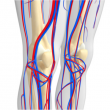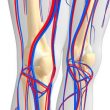One in five patients presenting perioperative MI during non-cardiac surgery should be readmitted within 30 days after surgery, and one in seven dies within the same period, according to the new study presented at ACC 2018 scientific sessions and simultaneously published in Circulation. These infarctions could be considered a iatrogenic complication, given the obvious lack of proper...
ACC 2018 | SECURE-PCI: High Dose of Statins pior PCI Could Help
Patients undergoing acute coronary syndrome (ACS) loaded with a high dose of statins prior diagnostic catheterization do not seem to benefit from this strategy. However, when looking at those undergoing PCI alone (excluding all patients who had received surgery or medical treatment), the benefit appears as a reduction of combined major events. The benefit of atorvastatin loading...
ACC 2018 | DEFINE-FLAIR Sub-Analysis: iFR More Comfortable, Faster, and Much Cheaper
Using instantaneous wave-free ratio (iFR) to guide decisions on revascularization of intermediate lesions is cheaper than using fractional flow reserve (FFR). Based on costs from the DEFINE-FLAIR trial, researchers estimate the difference to be almost USD 1000. This should not be seen as good news for any given technology (iFR, in this case), but for physiologic...
What’s New in the European Guidelines on Peripheral Arterial Disease
Since the last version of the European guidelines on the diagnosis and treatment of peripheral arterial disease in 2011, there have been many trials and registries that warrant guideline adjustments in many aspects. The first novelty is the teamwork that gave way to these guidelines, which were written in collaboration with the European Society of...
ACC 2018 | COMBO: New Stent with Thin Struts and Pro-Healing Membrane
The new COMBO stent, comprised of thin struts plus a bioengineered layer of endothelial progenitor cells, is safe and effective at 1 year, according to this registry (the largest study on this device to date). This new stent could provide a better option for patients at high risk for bleeding who may not be able to...
Surgery Seems Superior to Angioplasty in Young Patients
Long-term follow-up of patients under 50 with multivessel coronary artery disease suggests surgery outcomes are significantly better than angioplasty outcomes. This study, presented at the Society of Thoracic Surgeons’ (STS) Annual Meeting, concludes that surgery should continue as plan A when it comes to young patients with three-vessel disease. Surgeons complain that many patients never actually...
Silent Diabetes Is the New Stealthy Enemy
One in three “nondiabetic” patients who undergo angioplasty with current drug-eluting stents have an altered glucose metabolism, which is associated with a 4-fold higher risk of events, according to a study that will be published soon in JACC Intv. One in three patients is definitely one patient too many, and four times higher is definitely...
What Is the Prognosis for Reinterventions in Critical Lower Limb Ischemia?
Infrapopliteal (below the knee, BTK) percutaneous transluminal angioplasty (PTA) has been acknowledged as a useful strategy in chronic critical limb ischemia (CLI), but artery calcification severity results in considerable restenosis. Repeat PTA and the management of trophic lesions help with wound healing. However, this conduct has not been extensively assessed. This study enrolled 152 patients (175 limbs)...
Lesion Targeting Seems to Be the Secret in Critical Ischemia
Ulcers that do not heal, thus threatening the integrity of a lower limb in patients with critical ischemia, is a main concern. Sometimes, despite successful revascularization, major amputation cannot be prevented. The anatomical description of angiosomes started in the 70s as a way of optimizing tissue grafts. Angiosomes are basically blocks of tissue that include...
Routine FFR/iFR Reclassifies Treatment Strategies in Half of Cases
Routine invasive physiology assessment at time of angiography reclassifies treatment strategies in a big number of patients with lesions in 2 or 3 vessels, according to the multicenter prospective study DEFINE REAL, recently published in JACC Cardiovascular Interventions. The information obtained by measuring fractional flow reserve (FFR) or instantaneous wave free ratio (iFR) made interventionists modify their original plans in...









